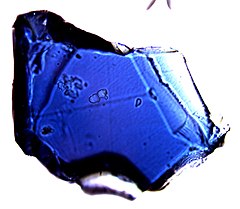Ringwoodite
| Ringwoodite | |
|---|---|

Crystal (~150 micrometers across) of Fo90 composition blue ringwoodite synthesized at 20 GPa and 1200 °C.
|
|
| General | |
| Category |
Nesosilicates Spinel group |
|
Formula (repeating unit) |
Magnesium Silicate (Mg2SiO4) |
| Strunz classification | 9.AC.15 |
| Crystal system | Cubic |
| Crystal class | Hexoctahedral (m3m) H-M symbol: (4/m 3 2/m) |
| Space group | Fd3m |
| Unit cell | a = 8.113 Å; Z = 8 |
| Identification | |
| Colour | Deep blue, also red, violet, or colourless (pure Mg2(SiO4)) |
| Crystal habit | Microcrystalline aggregates |
| Diaphaneity | Semitransparent |
| Specific gravity | 3.564 (Fo100); 3.691 (Fo90); 4.845 (Fa100) |
| Optical properties | Isotropic |
| Refractive index | n = 1.8 |
| Birefringence | none |
| Pleochroism | none |
| References | |
Ringwoodite is a high-pressure phase of Mg2SiO4 formed at high temperatures and pressures of the Earth's mantle between 525 and 660 km (326 and 410 mi) depth. It is polymorphous with the olivine phase forsterite (a magnesium iron silicate).
Ringwoodite is notable for being able to contain hydroxide ions (oxygen and hydrogen atoms bound together) within its structure.
Combined with evidence of its occurrence deep in the Earth's mantle, this suggests that there is from one to three times the world ocean's equivalent of water in the mantle transition zone from 410 to 660 km deep.
This mineral was first identified in the Tenham meteorite in 1969, and it is inferred to be present in large quantity in the Earth’s mantle.
Ringwoodite was named after the Australian earth scientist Ted Ringwood (1930–1993), who studied polymorphic phase transitions in the common mantle minerals olivine and pyroxene at pressures equivalent to depths as great as about 600 km.
Olivine, wadsleyite, and ringwoodite are polymorphs found in the upper mantle of the earth. At depths greater than about 660 km, other minerals, including some with the perovskite structure, are stable. The properties of these minerals determine many of the properties of the mantle.
Ringwoodite is polymorphous with forsterite, (Mg)2SiO4, and has a spinel structure. Spinel group minerals crystallize in the isometric system with an octahedral habit. Olivine is most abundant in the upper mantle, above about 410 km (250 mi); the olivine polymorphs wadsleyite and ringwoodite are thought to dominate the transition zone of the mantle, a zone present from about 410 to 660 km depth.
...
Wikipedia
